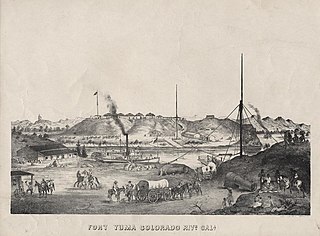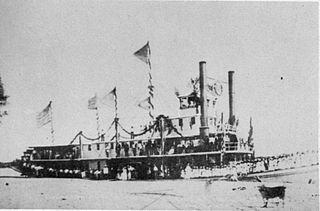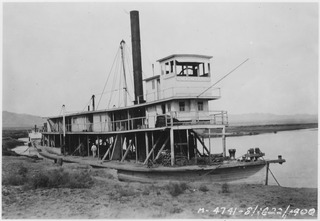
Port Isabel was a seaport established on Port Isabel Slough in 1865 during the American Civil War in Sonora, Mexico in the mouth of the Colorado River on the Gulf of California. It was founded to support the increased river traffic caused by the gold rush that began in 1862 on the Colorado River and the Yuma Quartermaster Depot newly established in 1864 to support the Army posts in the Arizona Military District. The slough was discovered in 1865 by the Captain W. H. Pierson of the schooner Isabel, that first used the slough to transfer its cargo to steamboats safe from the tidal bore of the Colorado River. Shortly afterward Port Isabel was established 3 miles up the slough and replaced Robinson's Landing as the place where cargo was unloaded in the river from seagoing craft on to flat bottomed steamboats of the Colorado River and carried up to Fort Yuma and points further north on the river.
Gila City is a ghost town in Yuma County in the U.S. state of Arizona. The town was settled in 1858 in what was then the New Mexico Territory.
George Alonzo Johnson (1824–1903) was an American entrepreneur and politician.

Steamboats on the Colorado River operated from the river mouth at the Colorado River Delta on the Gulf of California in Mexico, up to the Virgin River on the Lower Colorado River Valley in the Southwestern United States from 1852 until 1909, when the construction of the Laguna Dam was completed. The shallow draft paddle steamers were found to be the most economical way to ship goods between the Pacific Ocean ports and settlements and mines along the lower river, putting in at landings in Sonora state, Baja California Territory, California state, Arizona Territory, New Mexico Territory, and Nevada state. They remained the primary means of transportation of freight until the advent of the more economical railroads began cutting away at their business from 1878 when the first line entered Arizona Territory.
Pedrick's was a steamboat landing owned by John Pedrick that supplied wood to steamboats on the lower Colorado River in Sonora, Mexico, from the mid 1850s to the late 1870s. After the 1854 Gadsden Purchase, Pedrick's was within New Mexico Territory and Arizona Territory after 1863. Pedrick's landing was located 24 miles above Ogden's Landing and 31 miles below Fort Yuma. Pedrick's lay along the east bank of the river just above what is now the Sonora – Arizona border in modern Yuma County, Arizona.
Jaeger City, or Jaegerville, was a former settlement in what is now Imperial County, California, at Jaeger's Ferry on the Colorado River a mile downstream from Fort Yuma. It was named for L. J. F. Jaeger who ran the ferry there from 1851.
James Turnbull was the first steamboat captain on the Colorado River. His voyages supplying the Army at Fort Yuma demonstrated that the river was navigable by steamboats.
Uncle Sam, was a side-wheel paddle steamer and the first steamboat on the Colorado River in 1852.
Explorer was a small, custom-made stern-wheel steamboat built for Second lieutenant Joseph Christmas Ives and used by him to carry the U. S. Army Corps of Topographical Engineers expedition to explore the Colorado River above Fort Yuma in 1858.
Colorado, was a stern-wheel paddle-steamer, the third steamboat on the Colorado River, and first stern-wheel steamboat put on that river, in December 1855.
General Jesup was a side-wheel paddle-steamer, named for General Thomas Jesup then Quartermaster General of the United States Army, and was the second steamboat launched on the Colorado River, in 1854.

Cocopah II, was a stern-wheel paddle-steamer, the tenth steamboat on the Colorado River, first put on the river in 1867.

John Gunder North was a Norwegian born ship builder in San Francisco. During his career, he built 273 hulls of all kinds with 53 bay and river steamers, including the famed paddle steamers Chrysopolis, Yosemite and Capital.
Esmerelda, was a stern-wheel paddle-steamer, built for the Sacramento River trade, in 1864 it became the first of the opposition steamboats on the Colorado River. It was also the first steamboat to tow large cargo barges on that river, in May 1864 and to reach Callville, Nevada in 1866.

Benjamin Minturn Hartshorne was an American businessman rose to prominence during the California Gold Rush. He was involved in Sacramento River and Colorado River steamboats as well as maritime shipping.
Mohave was the first stern-wheel steamboat of that name running on the Colorado River between 1864 and 1875.
Olive City, or Olivia, was a short-lived town, steamboat landing, and ferry crossing on the Colorado River in what was then Yuma County, Arizona Territory, from 1863 to 1866. It was located on the Arizona bank of the Colorado River, 1 mile above its rival Mineral City and 1/2 mile above the original site of Ehrenberg, Arizona, 3 miles southwest of the location of La Paz. The GNIS location of Olive City (historical) is indicated as being in La Paz County, Arizona, but its coordinates in the present-day now put it across the river just within Riverside County, California. Olive City was named after Olive Oatman who had been, with her sister, survivors of the massacre of her family and a captive of the Yavapai until purchased from them by the Mohave who they lived with for several years.
George A. Johnson & Company was a partnership between three men who pioneered navigation on the Colorado River. Benjamin M. Hartshorne, George Alonzo Johnson and Alfred H. Wilcox. The George A. Johnson & Company was formed in the fall of 1852, and was reorganized as the Colorado Steam Navigation Company in 1869.

Mohave, the second stern-wheel steamboat of that name running on the Colorado River for the Colorado Steam Navigation Company (C.S.N.C) between 1875 and 1876. It was the first and only double smokestack steamboat to run on the river.

Cochan, (Quechan) last of the stern-wheel steamboats built for the Colorado Steam Navigation Company (CSNC). It ran on the Colorado River between 1900 and 1909.







